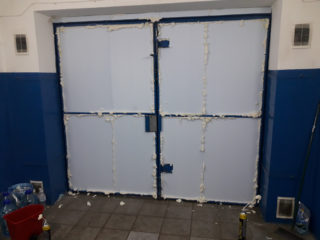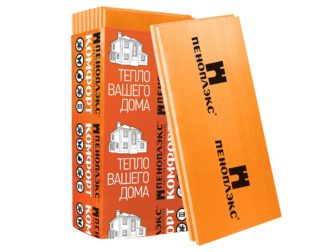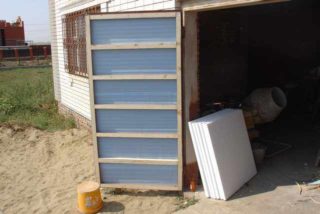To create a comfortable environment in the garage garage, it is recommended that the gate be insulated. This will also save the presentation of the car and its performance.
For what types of garage doors insulation is done
Most often, oar structures are installed in garages, which always need to be insulated. They are completely metal, and steel has a very low rate of thermal insulation. There are practically no obstacles between the cold of the street and the interior of the garage.
Sectional as well as up-and-over doors are very popular. Basically, they are made from sandwich panels in the factory. A layer of insulation made of polystyrene foam is applied to the steel outer shell. High thermal insulation characteristics of this material make unnecessary additional insulation of the garage door.
It is impossible to insulate rolling gates. This is due to their design features. The anti-vandal and thermal insulation properties of this design are so low that they can hardly be called suitable garage doors.
What to use as a heater
To perform the insulation of garage doors from the inside out with your own hands, you can choose a heater from a large number of offers from manufacturers.
Styrofoam
This is the common name for synthetic foam materials, the main ones for which are polymers. Polystyrene foam is the most famous type. In finished form, this is a lot of white balls connected into a monolith. It is often used by craftsmen making insulated garage doors. The material is lightweight, minimally hygroscopic, fireproof and durable.
Another material often used as a heat insulator is polyurethane foam foamed plastics. They come in two forms. The first is ordinary foam, and the second is polyurethane foam. For insulation, the last product is used. When applying it to the surface, all free cavities are filled.
Mineral wool
The material actively used in construction is divided into 3 subgroups: stone wool, slag wool, glass wool. The first insulation is not very often used for gates because of its hygroscopicity. Glass wool contains many very small glass particles. Its heat conductivity index ranges from 0.03 to 0.05 W / m * K. When working with this material, special safety precautions are recommended.
For the manufacture of slag are used metallurgical residues (slag). It has almost the same low thermal conductivity as the previous material. However, it is not worth it to insulate the garage door from the inside with her own hands - she does not tolerate metal proximity.
Polyurethane foam
It is applied to the surface by spraying. The thermal conductivity is very low. The material is non-toxic, but combustible. Despite all the positive qualities, it is not used very often, since it cannot be applied without a special installation.
Penoplex
Able to solve several problems at the same time:
- provide high-quality thermal protection;
- save money on heating;
- create a comfortable microclimate in the room.
The strong structure and low weight make this material convenient for installation.
Do-it-yourself insulation steps for garage doors from the inside
Surface preparation
Do-it-yourself insulation of a garage door begins with an inspection for peeling paint and rust. Detected violations of the integrity of the surface are eliminated. Next, processing is carried out with fine-grained sandpaper.
Production of a lathing
As a material, bars are used, which are sawed in accordance with the dimensions of the gate. At the same time, they try to stack whole pieces whenever possible. The bolts and all available holes are framed. For the fastening of the bars, self-tapping screws are used, the holes for which are made at a distance of no more than 25 cm. The length of the fastening elements is selected so that their tip does not pass through the bar.
Gate insulation
The stage begins with marking on the insulation. It is done in such a way that the workpiece fits tightly into the space between the bars, leaving no gaps. After that, the elements are cut. Here, as a rule, third-party assistance is required.
In order for the insulation to hold firmly in its “nests”, its surface is coated with silicate glue. You can also extrude polyurethane foam sealant. Its advantage is that during the formation it fills all the empty spaces, if any, formed during installation.
Facing the inside of the door
Important from a practical and aesthetic point of view is the stage of sheathing the inner surface of the insulated gate. There are several options that are popular:
- Rail wagon trim. This inexpensive environmentally friendly material is quite presentable. She is not afraid of temperature extremes and mechanical influences. Self-tapping screws are used to fasten the lining to the frame.
- Use of PVC panels. Their surface does not require special care. The installation process is simple and fast. The service life is long, but the panels do not tolerate mechanical stress.
- Moisture resistant plywood has high technical and environmental characteristics. She has one drawback - not for everyone an affordable price.
- OSB panels. With the help of this inexpensive material, it is possible to reliably and aesthetically sheathe the entrance to the garage.
The choice of material depends on the personal preferences of the owner and his material capabilities.
Additional measures
To get the desired result, you need to warm the gaps. No matter how conscientiously the work is performed, it is still not possible to avoid the occurrence of cracks. Their presence allows cold air to enter the garage.
You can get rid of gaps with thresholds and inserts. Vinyl inserts are glued along the edges of the wings. As glue, as a rule, paint is used. Before setting the threshold, dust and dirt are removed from the surfaces. For fixing, special glue is used.








